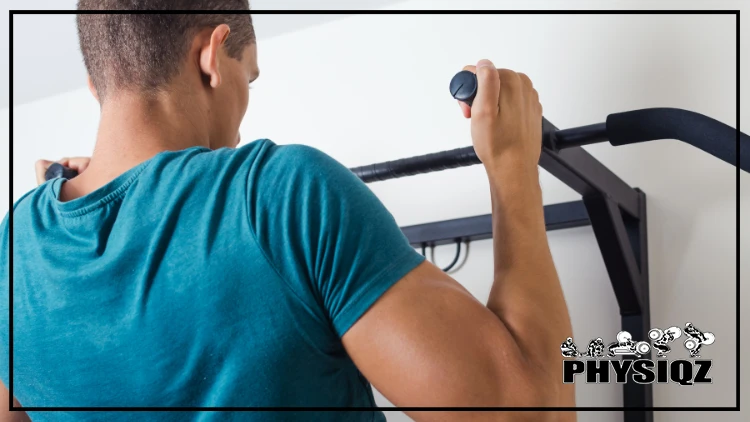
Instead of the traditional pull up form where with palms are facing each other, the neutral grip pull up muscles worked are much more broad and inclusive, and more heavily target the lats.1
Nobody is really doing these because they may only be familiar with the overhand and underhand grips, but neutral pull ups should be cycled in and out of any well-balanced upper body routine and are ideal for those with shoulder injuries too.
Neutral Grip Pull Up Muscles Worked
Neutral grip pull ups, also often referred to as “hammer grip”, are similar to other pull up positions and grips as far as working the upper and middle back, shoulders, abdominal muscles, and core.
However, those trying to build muscle and gain strength or who might be getting stronger but not bigger should make neutral pull ups part of their workout; this grip targets more muscles overall and can therefore provide more efficient strength and size increases to anyone performing them.
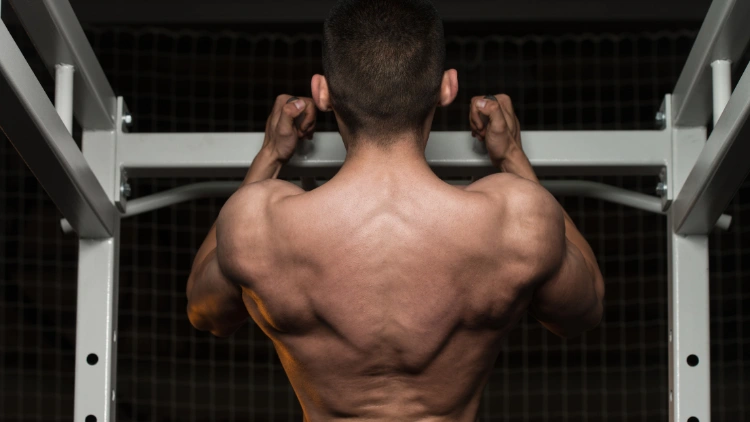
Source: Ibrakovic via Canva.com2
Take a look at the specific muscles targeted by neutral grip pull ups and where each is located.
Lats (Latissimus Dorsi)
The latissimus dorsi muscles are huge, taking the number one spot for largest muscles in the back, and are commonly targeted in powerbuilding programs and powerlifting routines for good reason.
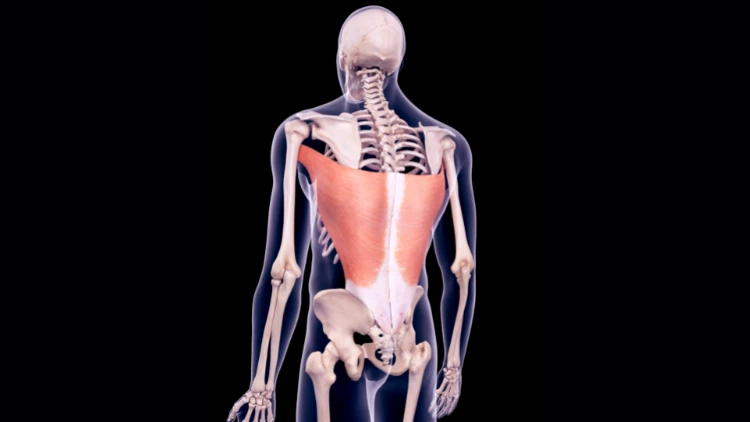
Source: Science Photo Library via Canva.com3
The lats are one of the main muscles that make pull ups possible in the first place, as they are responsible for extension and adduction and play a large part in movement throughout the shoulders. The lats also play a synergistic role in flexion and extension of the lumbar spine, as they extend all the way from the backs of the arms down towards the middle and lower back.
Brachioradialis
This muscle lies on the lateral side of the forearm and helps flex the forearm around the elbow as well as helping movements of the biceps brachii.
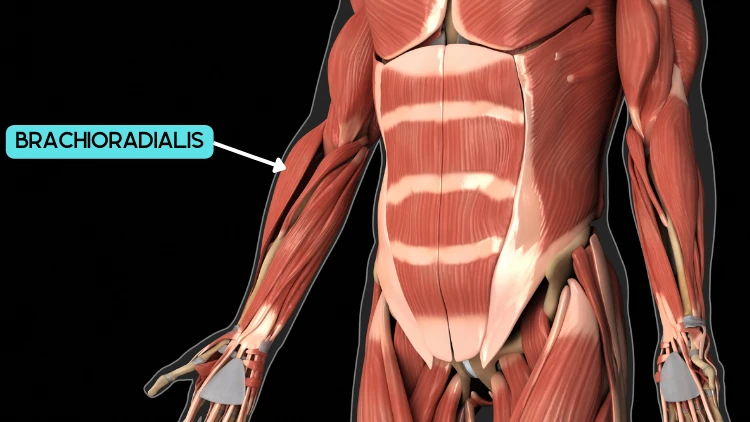
Source: janulla via Canva.com4
The brachioradialis is capable of both pronation when the forearm is pronated and supination when the forearm is pronated. This muscle is especially useful when lifting weight slowly with the forearm flexed and when making quick movements.
Brachialis (Brachialis Anticus)
The brachialis, sometimes called the “Teichmann muscle”, sits just above the elbow and helps it flex. This muscle is just beneath the biceps brachii and works in tandem with the brachioradialis to flex the elbow, but does not have supination or pronation capabilities in relation to the forearm like the brachioradialis does.
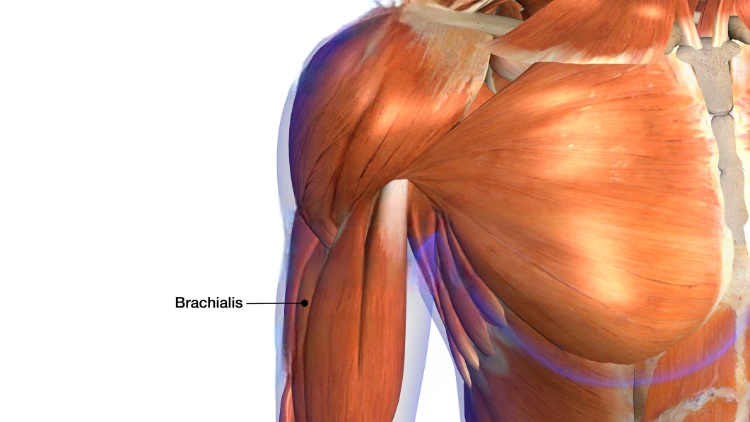
Source: Hank Grebe via Canva.com5
Biceps (Biceps Brachii)
The two-headed bicep is a large muscle in each arm that runs between the shoulder and elbow, serving to both flex at the elbow and supinate the forearm, meaning turning the palm upwards. The biceps play a major role in lifting such as in the act of lifting a dumbbell to the chest with an underhand grip or even carrying a bag of groceries.
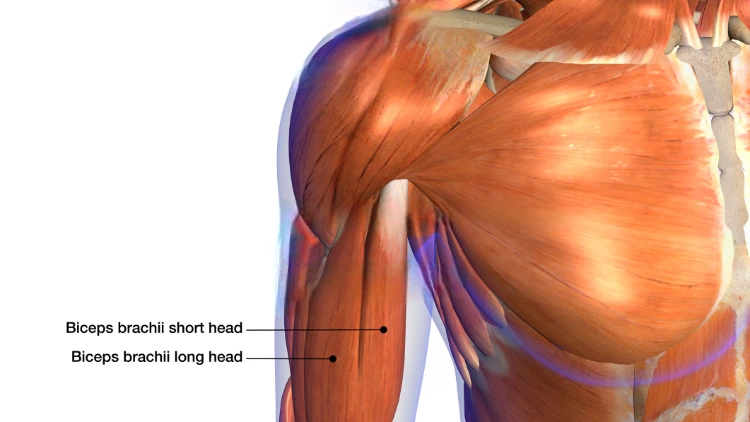
Source: Hank Grebe via Canva.com5
The biceps brachii also have minor parts in adduction, abduction, and stabilization of the shoulder.
Obliques (Abdominal Internal & External Obliques)
The internal and external obliques are abdominal muscles that assist with respiration–specifically exhalation, rotation of the trunk and spine, bending to each side, and pulling the chest down to compress the abdominal muscles and cavity.
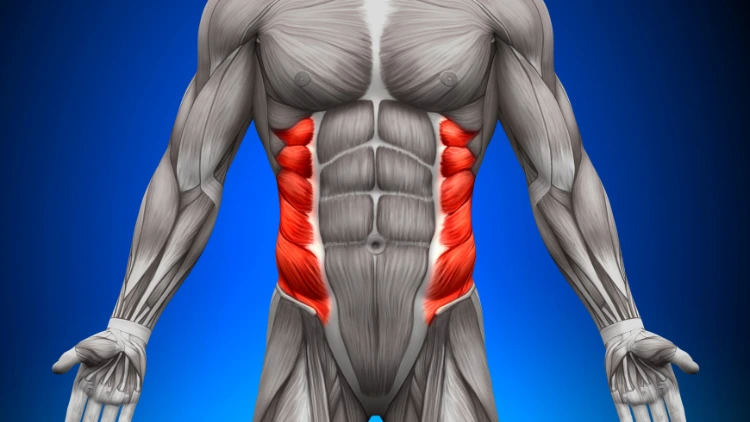
Source: decade3d via Canva.com6
Maintaining or gaining strength in the obliques is important as they help with breathing and mobility.
Pectorals (Pectoralis Major & Pectoralis Minor)
One of the largest muscle groups in the upper body, the pectoralis major and minor are together simply called pectorals and play a vital role in the upper body: initiating horizontal, vertical, and rotational movements throughout the arms and shoulders.
Connecting the chest to the shoulders and arms, the pectoralis major helps extend, flex, and rotate the humerus to move the upper arm. The pectoralis minor sits beneath the pectoralis major, attaches to the ribs, and helps keep the scapula stable.
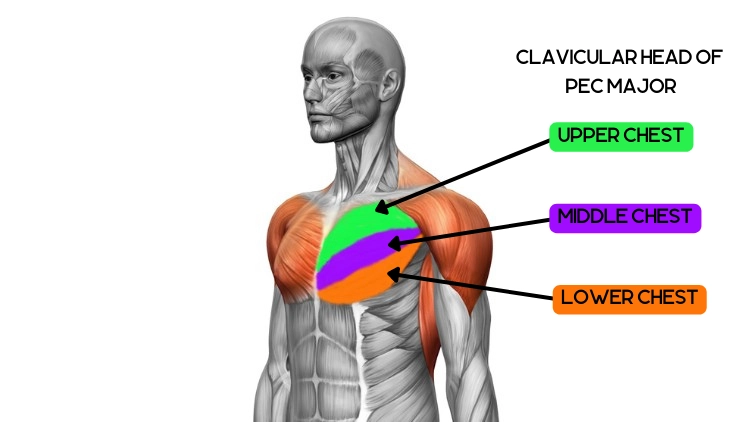
Source: Science Photo Library via Canva.com7
These muscles are used constantly in lifting, sports, and countless daily activities at home and work, so keeping the pectorals strong is of paramount importance.
Triceps (Triceps Brachii)
The triceps are on the back of the upper arm between the shoulder and elbow, opposite the biceps, and carry the most responsibility for extension of the elbow. The triceps offer stabilization of the shoulder and help to adduct the arms.
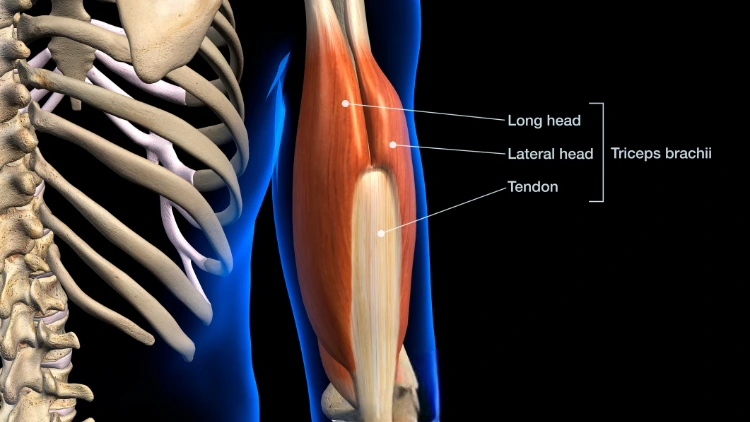
Source: Hank Grebe via Canva.com8
The three headed muscle of the arm (medial, lateral, and long), the tricep can be worked either in compound exercises or isolated and targeted movements to increase muscle growth and strength and, in turn, provide greater shoulder stability and arm strength.
Abs (Rectus Abdominis)
The rectus abdominis is a paired muscle in the core, running from the pubic symphysis up to the xiphoid process and ribs, each pair separated down the middle by connective tissue.
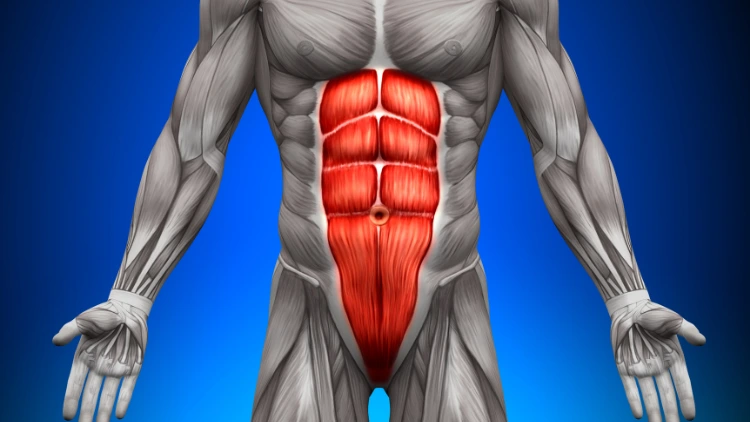
Source: decade3d via Canva.com9
Running down the whole length of the abdomen vertically, these are large muscles that help with.
- Posture
- Flexing of the lumbar spine
- Bringing the rib cage and pelvis closer together
- Keeping internal organs in their proper places
- Respiration (exhalation)
Traps (Trapezius)
A large trapezoid-shaped muscle on each side of the spine, the traps reach from the occipital bone down to the lower thoracic vertebrae and across to the spine of the scapula to aid in scapula motion, spinal movements, and stabilization of the arms.
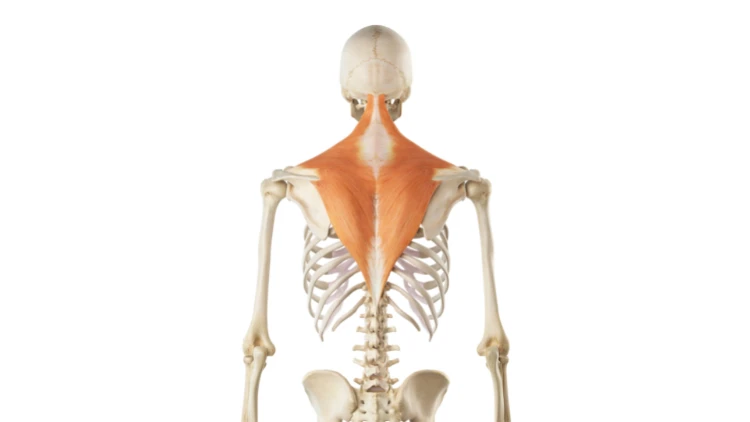
Source: Science Photo Library via Canva.com10
The trapezius is comprised of three parts: upper (descending), middle (transverse), and lower (ascending). Each of these parts assists with particular functional aspects of the scapula movement, arm support, and spinal movements.
Underdeveloped or atrophied traps can cause issues with arm abduction and adduction and poor neck posture which can lead to pain and discomfort or lack of mobility. Thankfully, this can often be reversed as strengthening the trapezius can help improve posture and relieve neck pain.11
Rotator Cuff
The rotator cuff is not a single muscle but a group of tendons and muscles that provide range of motion, stability, and control to the shoulders and upper arms. Providing abduction of the shoulder and working with the deltoids to raise the arms, this group of muscles is key to proper arm movement.
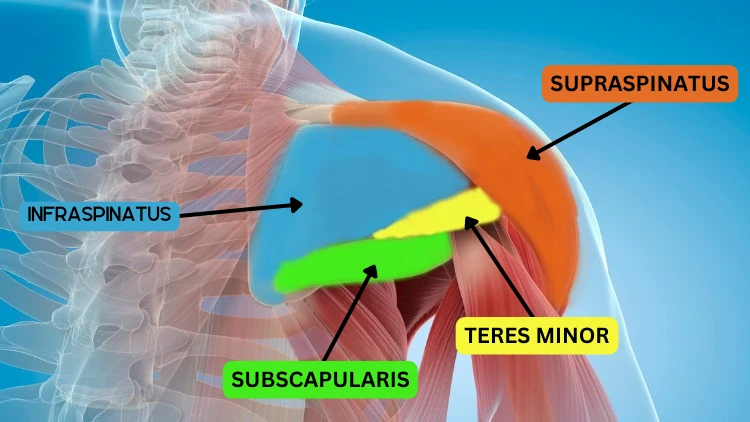
Source: Science Photo Library via Canva.com12
Unfortunately tearing of the rotator cuff is a frequent injury in athletes and non-athletes alike and since re-tearing of the rotator cuff after initial tearing is very common, it’s very important to strengthen these muscles.13
Deltoids (Musculus Deltoideus)
Deltoids sit right on top of the shoulders and help to both move (abduct and lift forward, backward, and sideways) and stabilize the arms and shoulders. Deltoids work antagonistically to the lats and pectorals in adduction, ensure the humeral head does not become dislocated while carrying heavy objects, and elevate the arms.
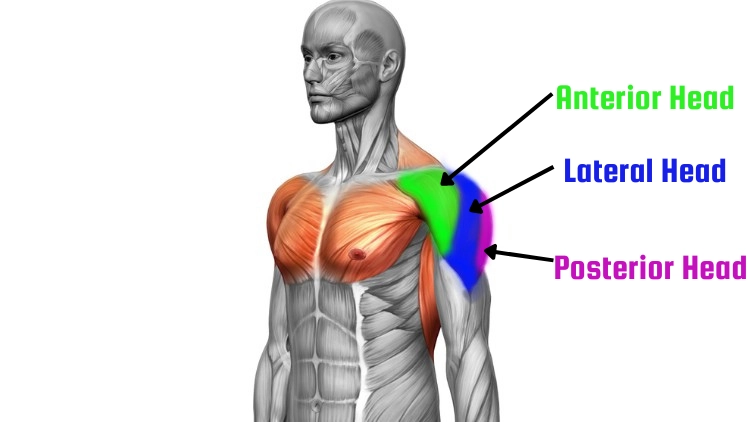
Source: Science Photo Library via Canva.com7
In a neutral grip pull up, the anterior deltoids (front delts) are worked most with minimal lateral deltoid (side delt) activation.
Teres Major
The teres major attaches to the scapula and humerus on each side underneath the shoulder near the back of the armpit, just above the lats, and helps to adduct, extend, and rotate the humerus, and works with the lats to bring the humerus down and back.

Source: Hank Grebe via Canva.com14
Rhomboid Major
Connecting to the scapula and vertebrae of the spine, the rhomboid major helps retract the scapula back towards the spinal column, works with the pectoralis minor to keep the scapula in place along the rib cage, and assists with general stability of the scapula.
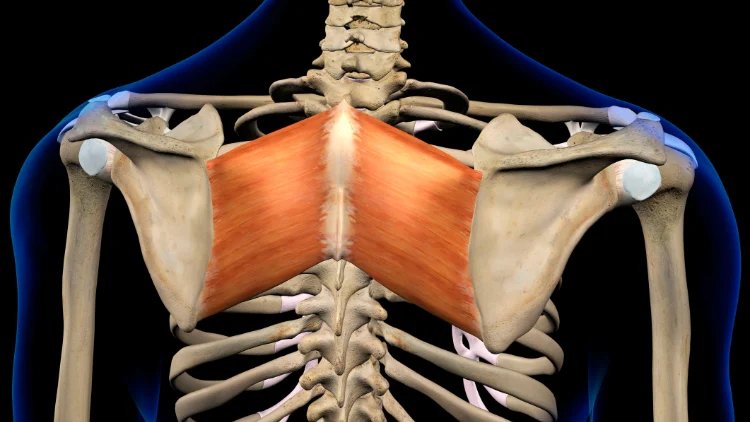
Source: Hank Grebe via Canva.com15
Muscles Worked With Different Types of Pull Up Grips
Various pull up grips work largely the same muscles and muscle groups, but differing grips allow for certain muscles to be much more prioritized or targeted. Although the same muscles might be worked, one performing neutral grip pull ups would likely feel much more of a burn in their lats than someone with an underhand grip who focused more on their biceps.
Notably, for those interested in or following an eccentric training program, variations in hand grip surprisingly don’t make much of a difference in the eccentric phase of a pull up; all grips had similar results and muscle engagement in this stage.16 However, the concentric phase of each pull up grip variation brought about vastly higher peak muscle activation in the biceps, brachioradialis, and pectoralis major compared to the muscle activation in the eccentric phase.17
This does not mean that eccentric training isn’t valuable in pull ups–just that it’s equally valuable in each grip, whereas concentric differences are more drastic from grip to grip.
Again, it’s not so much a matter of which muscle is worked in each, but which muscles are emphasized and targeted. Let’s delve into the types of pull ups and muscles worked with different pull up grips.
Reverse Grip Pull Up (Underhand Pull-Up) vs Overhand Pull Up (Pronated Pull Up) vs Neutral Grip Pull Ups
Underhand chin-ups are ideal for working the upper back and biceps while overhand focuses on the triceps and both overhand and neutral grips allow for more targeted work on the lower lats. The wideness or narrowness of one’s grip will also influence which muscles are worked and how much.
Since muscle engagement varies between grips, taking advantage of periodization to supercharge your gains, a long-term periodization program can incorporate each of these variations for maximized and well-balanced gains in strength and size.
Muscles Emphasized With Reverse Grip Pull Ups (Underhand Pull-Up): The reverse grip pull up–also called a supinated pullup–will target the biceps and trapezius more than the other grip variations, but does not engage the lats quite as much.
The biceps are the main focus and activated most in a underhand pull-up and this grip is easier for most people than a pronated grip.
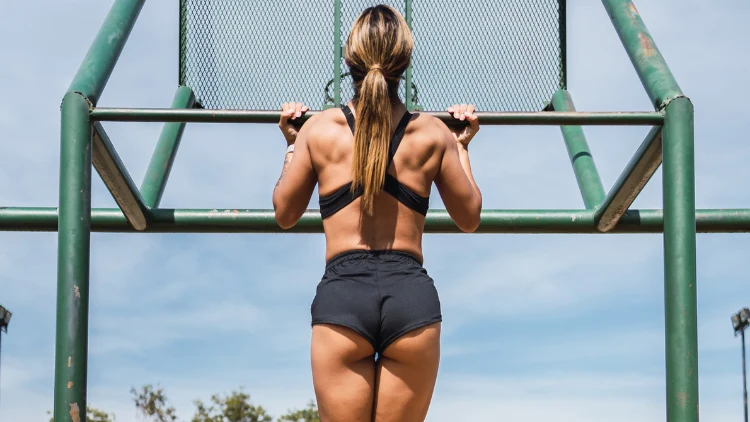
Source: renestevensphotos via Canva.com18
Muscles Emphasized With Overhand Pull Ups (Pronated Pull Up): Overhand or pronated pull ups still certainly utilize the biceps, but much less so than in a supinated position. Overhand pull ups recruit the deltoids and lower lats more.
It’s recommended to do some chest workouts prior to pronated pull ups to help loosen up the chest and make it more open and flexible for comfort during this exercise.

Source: eclipse_images via Canva.com19
Muscles Emphasized With Neutral Grip Pull Ups: Neutral grip pull ups are the easiest of the three pull up grips, as far more muscles are recruited to achieve each rep.
Added muscles working to lift the body allow for more reps or even for some weight to be added to a lifting belt to increase gains in strength and hypertrophy throughout the back and shoulders.
he muscles targeted by a neutral grip pull-up include all those mentioned above, but it will particularly emphasize the lower lats more than supine pull-ups. The lats, brachialis, and brachioradialis are the three muscles most emphasized with the hammer grip that are not as engaged in the other positions.
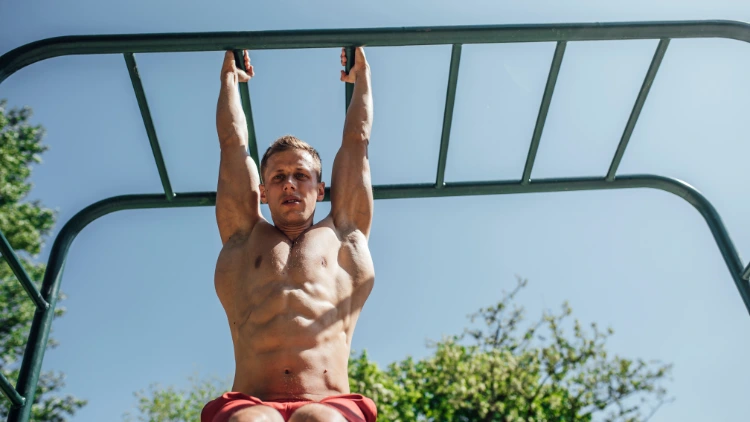
Source: FreshSplash via Canva.com20
Ensure the shoulders are kept down and back to really get a good lower lat workout in while performing a neutral pull up routine.
Furthermore, many people find the hammer grip to be most comfortable and able to give the deepest stretch in the bottom position.
Narrow Grip Pull Ups vs Wide Grip Pull Ups
Close grip neutral pull ups are more similar to supine grip; the narrower the grip, the more the biceps are targeted. On the other hand, a wider neutral grip will give results more comparable to the pronated grip, meaning that the lower lats will do more work the wider the hand distance.
Muscles Emphasized With Narrow Grip Pull Ups: Close neutral grip pull ups can be performed if the pull up bar has varying perpendicular bar distances and a narrow distance option.
While this grip still engages the lats, the biceps will be really activated with help from the rhomboids, levator scapulae, and teres major muscles to strengthen and build the back and shoulders.
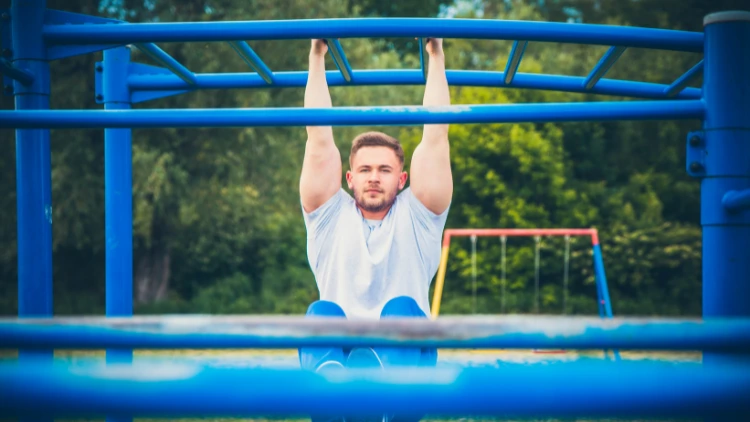
Source: LordHenriVoton via Canva.com21
Muscles Emphasized With Wide Grip Pull Ups: If a wider option is available on the pull up bar, a neutral wide grip pull up will really recruit the lower lats and move muscle activation somewhat down the back.
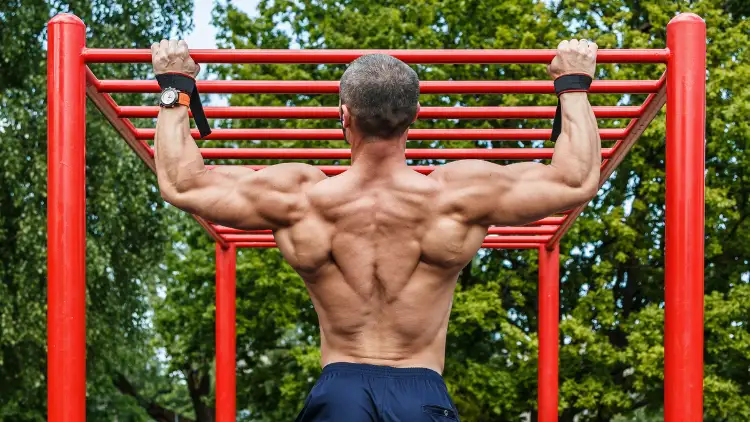
Source: A’s Images via Canva.com22
As opposed to the close grip targeting the biceps, upper back and shoulders most, the wide grip will focus on traps, abdominal muscles, and obliques. The wide grip will also bring in some tricep activation as an antagonistic muscle to the biceps.
Step-by-Step Guide on How To Do a Neutral Grip Pull Up
A neutral grip pull up does not require any added weights or equipment other than the pull up bar, as this adduction exercise relies solely on moving one’s body weight.23
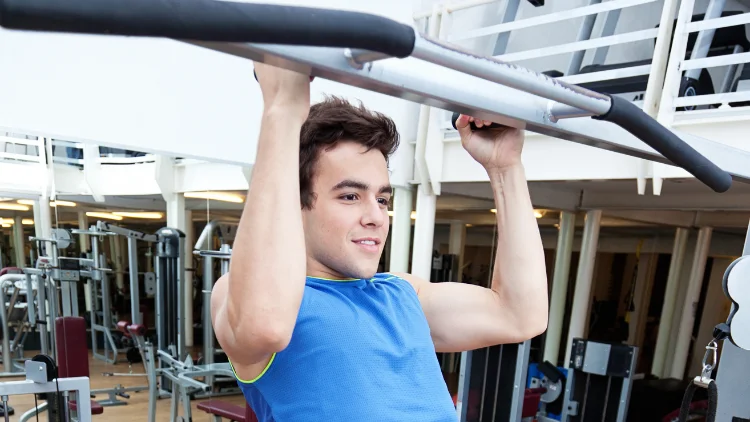
Source: MivPiv via Canva.com24
- To get in starting position, grip parallel pull up bars with palms facing each other and body hanging loose below, arms extended.
- Activating and tensing the core, exhale and pull the entire body up by pulling on the bar and queuing the elbow down and back. Do not flail or use momentum, but aim for a smooth and controlled movement, bringing the chin at least to bar height
- Come up to just above the eyes, the chin, the neck or sternum (pick one and do it consistently), pause for a moment at the top, inhale, and slowly lower the body back down to the starting position to complete one rep.
Common Form & Technique Mistakes
Some common form and technique mistakes such as letting the shoulders roll forward or trying to use momentum to move the body can easily lead to lack of muscle engagement, partial engagement, or worse–shoulder pain or injuries from added strain.
Common mistakes made during pull ups include:
- Flailing elbows or legs
- Failing to extend down fully
- Keeping elbows too far forward or close together
- Not pulling chin up to bar level
- Holding one’s breath
- Inhaling on the way up/exhaling on the way down
- Not keeping shoulders back
Benefits of Neutral Grip Pull Ups Over Other Alternatives
Neutral grip pull ups are the ultimate option for those who want to utilize and strengthen the most muscles at once, maximize lat growth, and simply have the most comfortable grip.
Since supine grip activates the biceps and traps more, whereas neutral and pronated grips focus more heavily on the lats, those wanting to target lat growth will benefit from a neutral position.25
Hammer grip pull ups can be integrated into a PHUL hypertrophy training program as part of the upper body focus on muscle gains.
Pull Up Variations To Try
Although there is no universal standard or number of average pull ups by age, children up to teenagers can usually complete anywhere from 0-25, whereas by around age 18 this number should slowly progress until it peaks with strength at approximately age 25-30 (with even an expert not usually being able to hit 40) before declining again.
Though this number will of course vary drastically from person to person, this bell curve is fairly representative of strength by age.
Pull up variations that can be practiced and honed for proper form include:
- Towel pull ups (towel hanging evenly over the bar, grab one end in each hand and complete a pull up gripping only the towel)
- Negative pull ups (jump or raise yourself up to the bar, then lower your body very slowly back down over 5-10 seconds)
- Around the world (with a wide grip, slowly pull your body towards the right arm, back around to the left and back to center before lowering to starting position)
- Neutral grip scap pull ups require very little range of motion but work the lats and shoulders to build upper body strength.
- Chest to bar (instead of only bringing the chin to the bar, pull the upper body up and over the bar until the chest touches, then lower). This makes things more difficult, and is better overall due to the greater range of motion.
When To Use Neutral Grip Pull Ups
Use neutral grip pull ups when seeking heightened muscle engagement, lat hypertrophy or strength gains, or more reps per set. However, only use the neutral grip for one training mesocycle or certain period of time before swapping out for another variation to avoid tennis elbow, wrist injuries, lower lat strain and soreness.
By regularly exchanging variations, one can maximize muscle growth while preventing soreness or injury from overuse of certain muscles and ensuring not to neglect any areas.
How To Progress Neutral Grip Pull Ups & Beyond
Anyone in beginner powerlifting programs who may not be able to complete a pull up quite yet can work their way up by strengthening the neutral grip pull up muscles worked by performing lat pulldowns and rowing exercises. Any core strengthening routine will also get one closer to being pull up ready.
When it comes to pull ups versus push ups, pull ups work many more muscles in the same amount of movement but push ups do certainly have more than enough benefits to keep them in a training program. In fact, push ups help strengthen many muscles used in pull ups, so doing them can enhance and progress strength until one is capable of completing pull ups.
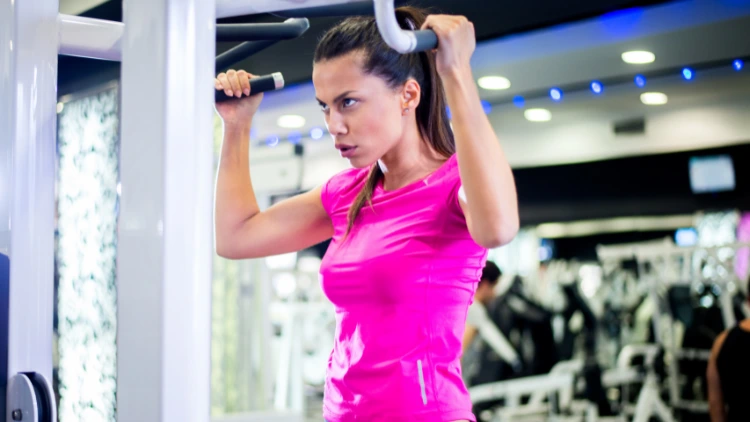
Source: EXTREME-PHOTOGRAPHER via Canva.com26
Though nobody really does neutral pull ups, perhaps many more people should begin incorporating them into their workouts as they’re the best variation. Neutral grip pull up muscles worked are greater in quantity than any other pull up variation and this grip targets the lats most, but other grips should still be used in rotation for all around muscle activation and stability.
Frequently Asked Questions
What Muscles Do Pull Ups Work vs Neutral Grip Pull Ups?
Anyone wondering do pull ups work shoulders, do pullups work biceps, or what muscles do pull ups work vs neutral grip pull ups might be surprised that they work very similar muscles, and both types work the shoulders and biceps.
However, neutral grip pull ups focus a little lower down the back such as working the lats, while traditional pull ups emphasize the upper back, shoulders, and biceps more.
What’s the Difference Between Chin Ups Muscles Worked vs Neutral Grip Pull Up Muscled Worked?
Chin ups muscles worked vs neutral grip include biceps and the upper back for chin ups, while neutral targets the lower lats and brachioradialis.
What Equipment & Gear Can I Use When Working on Pull Ups?
The pull up machine is obviously required, but other equipment and gear includes resistance bands, straps to ensure grip isn’t a limiting factor, and dip/pull up belts for safely adding weight if desired.
References
1Sinkov, Igor. Canva. Accessed 18 April 2023. <https://www.canva.com/photos/MADCW9V0MVQ-pull-ups-at-gym/>
2Ibrakovic. Canva. Accessed 18 April 2023. <https://www.canva.com/photos/MADCNjBstXY-male-bodybuilding-athlete-doing-pull-ups/>
3Science Photo Library. “F017/1255.” Canva, 20 April 2019. Accessed 13 April 2023. <https://www.canva.com/photos/MADq3vbyn-k-f017-1255/>
4janulla. Canva. Accessed 17 April 2023. <https://www.canva.com/photos/MADE-QhX6Eo-muscular-system-anatomy/>
5Hank Grebe. “Labeled Anatomy Chart of Neck and Shoulder Muscles on White Background.” Canva. Accessed 13 April 2023. <https://www.canva.com/photos/MADZASGJL7w-labeled-anatomy-chart-of-neck-and-shoulder-muscles-on-white-background/>
6decade3d. “External Oblique – Anatomy Muscles.” Canva. Accessed 13 April 2023. <https://www.canva.com/photos/MADerLrH9sQ-external-oblique-anatomy-muscles/>
7Science Photo Library. “The muscles involved in standing biceps curl. The stabilizing muscles are highlighted.” Canva. Accessed 12 April 2023. <https://www.canva.com/photos/MADmTGwAFbo-the-muscles-involved-in-standing-biceps-curl-the-stabilizing-muscles-are-highlighted-/>
8Hank Grebe. “Labeled Anatomy Chart of Shoulder, Elbow and Triceps Muscles in Skeleton on Black Background.” Canva. Accessed 12 April 2023. <https://www.canva.com/photos/MAEJnzTxmJU-labeled-anatomy-chart-of-shoulder-elbow-and-triceps-muscles-in-skeleton-on-black-background/>
9decade3d. “Abs – Anatomy Muscles.” Canva. Accessed 12 April 2023. <https://www.canva.com/photos/MADerFwn3js-abs-anatomy-muscles/>
10Science Photo Library. “”Human trapezius muscles.” Canva. Accessed 13 April 2023. <https://www.canva.com/photos/MADmTLHptgU--human-trapezius-muscles/>
11Park, S.-H., & Lee, M.-M. (2020). Effects of Lower Trapezius Strengthening Exercises on Pain, Dysfunction, Posture Alignment, Muscle Thickness and Contraction Rate in Patients with Neck Pain; Randomized Controlled Trial. National Institute of Health. Retrieved January 25, 2023, from <https://www.ncbi.nlm.nih.gov/pmc/articles/PMC7115121/>
12Science Photo Library. “”Shoulder muscles.” Canva. Accessed 12 April 2023. <https://www.canva.com/photos/MADmTDg8VA4--shoulder-muscles/>
13Mandaleson, A. (2021, August). Re-tears after rotator cuff repair: Current concepts review. National Institute of Health. Retrieved January 25, 2023, from <https://www.ncbi.nlm.nih.gov/pmc/articles/PMC8170498/>
14Grebe, Hank. Canva. Accessed 18 April 2023. <https://www.canva.com/photos/MADZWOgzm3s-labeled-anatomy-chart-of-neck-and-back-muscles-on-black-background/>
15Hank Grebe. “Male Rhomboid Major Back Muscles in Isolation on Skeleton.” Canva. Accessed 12 April 2023. <https://physiqz.com/wp-content/uploads/2023/01/Male-Rhomboid-Muscle.webp>
16Wikipedia the Free Encyclopedia. (2023, January 23). Eccentric Training. Wikipedia. Retrieved January 25, 2023, from <https://en.wikipedia.org/wiki/Eccentric_training>
17Dickie, J., Faulkner, J., Barnes, M., & Lark, S. (2017, February). Electromyographic analysis of muscle activation during pull-up variations. National Institute of Health. Retrieved January 25, 2023, from <https://pubmed.ncbi.nlm.nih.gov/28011412/>
18renestevensphotos. “Athlete Doing Pull Ups.” Canva, 13 December 2011. Accessed 13 April 2023. <https://www.canva.com/photos/MAEk1C9Wpcc-athlete-doing-pull-ups/>
19eclipse_images. “Doing pull ups.” Canva, 13 December 2011. Accessed 13 April 2023. <https://www.canva.com/photos/MAEEE2vo8Ko-doing-pull-ups/>
20FreshSplash. Canva. Accessed 18 April 2023. <https://www.canva.com/photos/MAEJApRtAio-athlete-doing-pull-ups/>
21LordHenriVoton. Canva. Accessed 18 April 2023. <https://www.canva.com/photos/MAEI14IFtj0-man-doing-pull-ups-in-the-park/>
22A’s Images. “Man Doing Pull-Ups on Horizontal Bar.” Canva, 13 December 2011. Accessed 13 April 2023. <https://www.canva.com/photos/MAE3QpPsLoI-man-doing-pull-ups-on-horizontal-bar/>
23Wikipedia the Free Encyclopedia. (2023, January 21). Anatomical Terms of Motion: Abduction and Adduction. Wikipedia. Retrieved January 25, 2023, from <https://en.wikipedia.org/wiki/Anatomical_terms_of_motion#Abduction_and_adduction>
24MivPiv. Canva. Accessed 18 April 2023. <https://www.canva.com/photos/MAEEwjPX9YQ-young-man-doing-pull-ups/>
25Koehler, J.D., & Helm, K. (2023). How Grip Variation Effects Shoulder Complex Muscle Activation During the Pull-Up. Valparaiso University. Retrieved January 25, 2023, from <https://scholar.valpo.edu/cgi/viewcontent.cgi?article=1923&context=cus>
26EXTREME-PHOTOGRAPHER. “Pull-ups.” Canva, 13 December 2011. Accessed 13 April 2023. <https://www.canva.com/photos/MAEJKwxIpCA-pull-ups/>